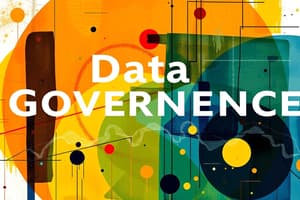Podcast
Questions and Answers
Which of the following scenarios best exemplifies the role of data integration in data management?
Which of the following scenarios best exemplifies the role of data integration in data management?
- An analyst cleans a dataset by removing duplicate entries and correcting inconsistencies before analysis.
- A business decides to store all its sales data on a cloud-based server for better accessibility.
- A company implements a new firewall to protect its customer database from cyber threats.
- A marketing team combines customer data from their CRM and social media platforms to create targeted advertising campaigns. (correct)
A company is struggling with inconsistent customer data spread across multiple departments. Which data management practice would MOST directly address this issue?
A company is struggling with inconsistent customer data spread across multiple departments. Which data management practice would MOST directly address this issue?
- Establishing a data governance policy to standardize data definitions and access. (correct)
- Implementing a data warehouse to store all historical data.
- Collecting more data from external sources to enrich the existing database.
- Using data visualization tools to identify patterns in existing datasets.
Which of the following is NOT a primary focus of data cleaning and preparation?
Which of the following is NOT a primary focus of data cleaning and preparation?
- Correcting errors and inconsistencies in data entries.
- Removing duplicate entries from a dataset.
- Filling in missing values in a dataset.
- Implementing security measures to protect data from unauthorized access. (correct)
A hospital wants to improve patient care by analyzing data from various sources, including electronic health records, lab results, and patient surveys. Which data management practice is MOST relevant to achieving this goal?
A hospital wants to improve patient care by analyzing data from various sources, including electronic health records, lab results, and patient surveys. Which data management practice is MOST relevant to achieving this goal?
Which of the following scenarios highlights the importance of data governance and security?
Which of the following scenarios highlights the importance of data governance and security?
What is the primary goal of data management?
What is the primary goal of data management?
A small e-commerce business wants to understand its customer purchasing patterns. Which initial step in data management would BEST support this goal?
A small e-commerce business wants to understand its customer purchasing patterns. Which initial step in data management would BEST support this goal?
In the context of unstructured data analysis using PowerQuery for Excel, what is the initial and most crucial step that analysts should undertake?
In the context of unstructured data analysis using PowerQuery for Excel, what is the initial and most crucial step that analysts should undertake?
After identifying the goals of a data analysis project, which subsequent step is MOST critical when dealing with unstructured data?
After identifying the goals of a data analysis project, which subsequent step is MOST critical when dealing with unstructured data?
What is the PRIMARY purpose of establishing data governance and security policies within an organization?
What is the PRIMARY purpose of establishing data governance and security policies within an organization?
Which of the following measures is MOST effective in safeguarding personal and sensitive information, aligning with frameworks like GDPR, HIPAA, and CCPA?
Which of the following measures is MOST effective in safeguarding personal and sensitive information, aligning with frameworks like GDPR, HIPAA, and CCPA?
An organization is preparing for a regulatory audit. What practice BEST demonstrates transparency in data management?
An organization is preparing for a regulatory audit. What practice BEST demonstrates transparency in data management?
Which of the following actions is LEAST likely to be part of resolving data quality issues during data cleaning?
Which of the following actions is LEAST likely to be part of resolving data quality issues during data cleaning?
When preparing data for analysis, which task involves modifying and formatting data to facilitate easier analysis?
When preparing data for analysis, which task involves modifying and formatting data to facilitate easier analysis?
What is the primary benefit of accurate and well-prepared data in the context of data analysis?
What is the primary benefit of accurate and well-prepared data in the context of data analysis?
In the context of advanced data preparation, creating new variables or modifying existing ones to uncover additional insights is known as:
In the context of advanced data preparation, creating new variables or modifying existing ones to uncover additional insights is known as:
Which of the following is an example of normalization and scaling in data preparation?
Which of the following is an example of normalization and scaling in data preparation?
In an ETL pipeline designed to aggregate valuable information, what is the primary purpose of the data storage phase?
In an ETL pipeline designed to aggregate valuable information, what is the primary purpose of the data storage phase?
Which approach is LEAST related to outlier treatment in data preparation?
Which approach is LEAST related to outlier treatment in data preparation?
What does data enrichment primarily aim to achieve in the data preparation process?
What does data enrichment primarily aim to achieve in the data preparation process?
Which of the following information types, when aggregated, would be MOST useful for optimizing fleet fuel consumption?
Which of the following information types, when aggregated, would be MOST useful for optimizing fleet fuel consumption?
A transportation company wants to monitor the temperature of goods in transit. Which sensor would be MOST relevant for this purpose?
A transportation company wants to monitor the temperature of goods in transit. Which sensor would be MOST relevant for this purpose?
Why is automating repetitive cleaning and preparation tasks considered critical in advanced data preparation?
Why is automating repetitive cleaning and preparation tasks considered critical in advanced data preparation?
What is the MOST important initial step one should take before starting to clean a dataset?
What is the MOST important initial step one should take before starting to clean a dataset?
What is the primary characteristic of relational databases that makes them suitable for applications requiring ACID transactions?
What is the primary characteristic of relational databases that makes them suitable for applications requiring ACID transactions?
Why might a company choose a Data Lake over a Data Warehouse for storing transportation data?
Why might a company choose a Data Lake over a Data Warehouse for storing transportation data?
What is the relationship between the types of data available (structured, semi-structured, etc.) and the cleaning process?
What is the relationship between the types of data available (structured, semi-structured, etc.) and the cleaning process?
Which of the following SQL commands is used to modify existing data in a database table?
Which of the following SQL commands is used to modify existing data in a database table?
A trucking company wants to track the location of their vehicles in real-time. Which of the listed information is needed to achieve this?
A trucking company wants to track the location of their vehicles in real-time. Which of the listed information is needed to achieve this?
A business is using a relational database. Which of the following characteristics is MOST important for maintaining data integrity?
A business is using a relational database. Which of the following characteristics is MOST important for maintaining data integrity?
Which of the following is NOT a typical use case for relational databases?
Which of the following is NOT a typical use case for relational databases?
A data analyst needs to retrieve a list of all employees from a database table named 'Employees'. Which SQL command should they use?
A data analyst needs to retrieve a list of all employees from a database table named 'Employees'. Which SQL command should they use?
Which of the following is the MOST critical reason for ensuring proper data storage in big data processing?
Which of the following is the MOST critical reason for ensuring proper data storage in big data processing?
In the data cleaning and preparation phase, what is the primary purpose of handling missing data?
In the data cleaning and preparation phase, what is the primary purpose of handling missing data?
Why is data transformation important in the data cleaning and preparation stage?
Why is data transformation important in the data cleaning and preparation stage?
Which of the following actions would BEST exemplify fixing data quality issues during the data cleaning process?
Which of the following actions would BEST exemplify fixing data quality issues during the data cleaning process?
What is the PRIMARY reason that clean, high-quality data is essential for big data analysis?
What is the PRIMARY reason that clean, high-quality data is essential for big data analysis?
In the context of data governance and security, what is the purpose of defining access controls?
In the context of data governance and security, what is the purpose of defining access controls?
Why is it important to create a data usage policy within an organization?
Why is it important to create a data usage policy within an organization?
What does data integration primarily involve in big data processing?
What does data integration primarily involve in big data processing?
An organization is implementing new data governance protocols to comply with GDPR. Which of the following actions would BEST align with these protocols?
An organization is implementing new data governance protocols to comply with GDPR. Which of the following actions would BEST align with these protocols?
Flashcards
Data Management
Data Management
The process of collecting, storing, organizing, and maintaining data for analysis.
Data Collection
Data Collection
Gathering data from various sources to address business problems.
Data Storage
Data Storage
Storing data securely and systematically using databases or cloud solutions.
Data Cleaning
Data Cleaning
Signup and view all the flashcards
Data Governance
Data Governance
Signup and view all the flashcards
Data Integration
Data Integration
Signup and view all the flashcards
Data Access and Analytics
Data Access and Analytics
Signup and view all the flashcards
Data Storage Importance
Data Storage Importance
Signup and view all the flashcards
Removing Duplicates
Removing Duplicates
Signup and view all the flashcards
Fixing Data Quality Issues
Fixing Data Quality Issues
Signup and view all the flashcards
Handling Missing Data
Handling Missing Data
Signup and view all the flashcards
Access Controls
Access Controls
Signup and view all the flashcards
Data Usage Policy
Data Usage Policy
Signup and view all the flashcards
Eliminate Duplicates
Eliminate Duplicates
Signup and view all the flashcards
Resolve Data Quality Issues
Resolve Data Quality Issues
Signup and view all the flashcards
Address Missing Values
Address Missing Values
Signup and view all the flashcards
Prepare Data for Analysis
Prepare Data for Analysis
Signup and view all the flashcards
Feature Engineering
Feature Engineering
Signup and view all the flashcards
Normalization and Scaling
Normalization and Scaling
Signup and view all the flashcards
Outlier Treatment
Outlier Treatment
Signup and view all the flashcards
Data Enrichment
Data Enrichment
Signup and view all the flashcards
Automating the Process
Automating the Process
Signup and view all the flashcards
Importance of Data Preparation
Importance of Data Preparation
Signup and view all the flashcards
ETL Pipeline
ETL Pipeline
Signup and view all the flashcards
Data Warehouse
Data Warehouse
Signup and view all the flashcards
Relational Databases
Relational Databases
Signup and view all the flashcards
NoSQL Databases
NoSQL Databases
Signup and view all the flashcards
Data Lakes
Data Lakes
Signup and view all the flashcards
ACID Properties
ACID Properties
Signup and view all the flashcards
Primary Key
Primary Key
Signup and view all the flashcards
Foreign Key
Foreign Key
Signup and view all the flashcards
SQL Commands
SQL Commands
Signup and view all the flashcards
Data Integrity
Data Integrity
Signup and view all the flashcards
Unstructured Data
Unstructured Data
Signup and view all the flashcards
ETL Tool
ETL Tool
Signup and view all the flashcards
Privacy Measures
Privacy Measures
Signup and view all the flashcards
Study Notes
Data Management: Basic Concepts and Fundamentals
- Data management is the process of collecting, storing, organizing, and maintaining data to ensure accessibility, accuracy, and readiness for analysis.
- It involves handling data throughout its lifecycle, from raw data collection to processing, storage, and preparation for decision-making.
Key Concepts
- Data Collection: Gathering relevant and comprehensive data from various sources (e.g., customer databases, sales records, social media).
- Data Storage: Secure and systematic data storage using systems like databases, data warehouses, or cloud storage solutions, enabling scalability and large-scale data management.
- Data Cleaning and Preparation: Ensuring data quality by removing duplicates, correcting errors, and handling missing values, critical for accurate analysis.
- Data Governance and Security: Establishing policies for data access, privacy, and compliance to protect sensitive information.
- Data Integration: Combining data from multiple sources (e.g., CRM systems, marketing platforms) to gain a holistic view for comprehensive analysis.
- Data Access and Analytics: Making data accessible to the right people at the right time using dashboards or analytics tools to support data-driven decision-making.
Data Collection
- What it is: The foundational step of gathering data relevant to business questions or objectives. Data can come from internal or external sources.
- Key steps:
- Identify data sources
- Define data types (structured, unstructured)
- Select collection methods
- Ensure ethical and legal compliance (data privacy laws)
Data Storage
- What it is: Storing collected data safely and efficiently, based on size, type, and access requirements.
- Key steps:
- Choose storage solutions (databases, data warehouses, data lakes, cloud storage)
- Organize data structure (schemas, table names, etc.)
- Ensure data backup and security (encryption, access controls)
Data Cleaning and Preparation
- What it is: Getting data into a suitable shape for analysis (data wrangling). Fixing errors, standardizing formats, and filling in missing information.
- Key steps:
- Remove duplicates
- Fix data quality issues (errors, inconsistencies)
- Handle missing data (imputation methods)
- Transform data for analysis (format conversion)
Data Governance and Security
- What it is: Managing data access, privacy, and security.
- Key steps:
- Define access controls (role-based access)
- Establish privacy and compliance standards
- Create a data usage policy
- Implement security protocols
Data Integration
- What it is: Combining data from multiple sources to get a unified view of the business.
- Key steps:
- Establish common data definitions
- Use ETL (Extract, Transform, Load) tools
- Ensure data synchronization
- Resolve data conflicts (discrepancies)
Data Access and Analytics
- What it is: Making data accessible for analysis and insights.
- Key steps:
- Implement business intelligence (BI) tools (e.g., Power BI, Tableau)
- Ensure role-based data access
- Enable self-service analytics
- Measure key metrics and KPIs (Key Performance Indicators)
Studying That Suits You
Use AI to generate personalized quizzes and flashcards to suit your learning preferences.




